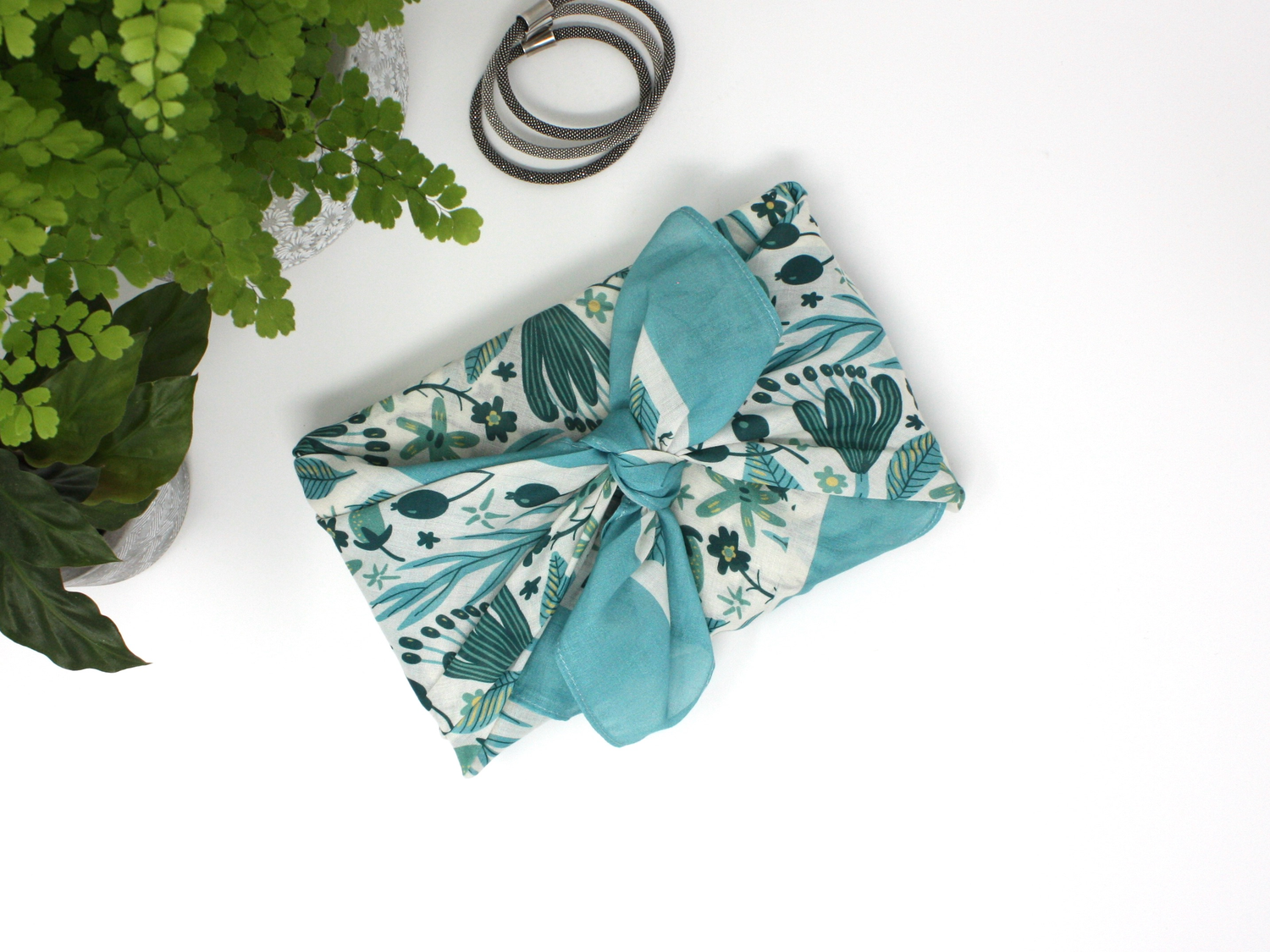Fabric wrapping is centuries old in the East, but here in the West it’s a pretty new idea. Here’s the complete lowdown.
What are fabric wraps?
Lets start at with the basics. Fabric wraps, or furoshiki as they’re known in Japan, are versatile square scarves. There’s no set size, but 40cm to 120cm is typical.
How do I pronounce "Furoshiki"?
Like “quinoa”, if you’ve only ever read the word “furoshiki’, it might be a while before you figure out if you’re saying it correctly. So, before we dive in let’s get that sorted…
Sounds like
Fuh-rosh-i-key
A very brief history
Whilst they’re often associated with Japan, fabric wraps have been used in other parts of Eastern Asia too.
In Korea fabric wraps are known as bojagi. They’re believed to date back 2000 years, when keeping something wrapped was believed to bring good luck. Later, becoming used in ceremonies like Weddings, where wrapping something was a way to show concern and respect.
In Japan tsutumi (wrapping) were used way back in the 8th century to protect precious items, like an early, prettier, bubble wrap. They then became used by the lords in the bath houses to wrap their clothes so they didn’t get muddled. Which is where they acquired the name furo (bath) shiki (spread) = furoshiki. But you can’t keep a good idea under wraps! And they became widely used by the general population for wrapping and carrying all sorts of things.

Sadly, with the arrival of plastic bags, the use of fabric wraps started to decline, but now they are B A C K (in capital letters)!!! Not just in the East, but rapidly spreading West as a multifunctional and zero waste alternative for packing and wrapping.
What can I use fabric wraps for?
Loads of ways! They’re incredibly versatile and your imagination is your limit.
Commonly people use furoshiki to:
- wrap presents
- tied into bags - handbag/shoulder bag/backpack, the choice is yours
- worn as a scarf
- hung as wall art
- tied into a cushion cover
- confine unruly laptop chargers and cables
- a hammock for ‘The Elf’ at Christmas
- protect delicate jewellery
- organise and separate items when packing a suitcase
- plant pot cover
The list of uses goes on….
Fabric especially comes into its own is for packing and wrapping awkward shapes. Need to gift wrap a frying pan? A ball? A toy without a box? Fabric is so much more pliable than paper it folds around awkward corners, doesn’t tear, and softly gathers rather than bunches, so looks so far neater.
And best of all you can reuse and repurpose your wrap again and again.
-2.png/:/cr=t:0%25,l:0%25,w:100%25,h:100%25/rs=w:1280)
Where can I buy furoshiki?
Furoshiki are simply hemmed, square cloths, so if you have a pretty scarf in your wardrobe, you can repurpose that and get started straight away.
Alternatively, you can buy fabric wrapping cloths from stores like ours www.kindlyyarn.co.uk
Or if you have spare fabric and are handy with a sewing machine, it’s fairly simple to make your own. Wraps can be made from any fabric; cotton, silk, recycled polyester are ideal. A lighter-weight fabric will be easier to tie and gathers and drapes nicely. A heavier-weight fabric will be more awkward to knot, but more protective for packaging. Although if it’s too heavy you can always simply wrap around the gift and secure with a ribbon or twine like an old fashioned, paper parcel (not technically ‘furoshiki’, but hey if it works).
How do I wrap with fabric?
It’s actually really easy. You could take your time making perfect pleats which is really calming, mindful practise.
But as a busy working mum, the reason I love wrapping with fabric is that it’s really simple and quick.
I even timed myself once, and wrapped a perfectly presentable gift with fabric in under 15 seconds. How’s that for speed? I probably couldn’t even have found the end of the Sellotape in that time.
Take a look at these videos for a couple of quick ways to wrap common shapes.
Or, check out these handy step by step diagrams published by the Japanese Ministry of the Environment for wrapping all sorts of items.
What size fabric wrap do I need?
This question depends on a couple things:
What sort of fabric? With a heavier fabric your knots will be bulkier, so you’ll need a slightly larger wrap.
And of course, what are you going to wrap? Below is a good guide:
· 55cm x 55cm fabric wrap – ideal for small and medium gifts; candles, T-shirt, photo frame, jewellery, toiletries or a bottle. Or can be tied into a small bag to hold purse, phone and keys.
· 80cm x 80cm fabric wrap – ideal for larger gifts, such as toys and games, jumper or jacket, or tied into a larger bag if you need an extra layer of clothing, or a couple of groceries.
If you’re still not sure on the size, it’s better to go for a wrap that’s slightly bigger. That way you can always fold it smaller, or wrap it round once again, or make the bows a bit bigger. They’re really flexible.
Who keeps a furoshiki?

So now you’ve got your gift beautifully wrapped and you’re on to giving it to the lucky recipient.
Wrapping paper just gets thrown in the bin, or recycling box. But fabric wraps are of course reusable, and so much nicer, so who gets to keep the wrap?
In the West fabric wraps are generally viewed as an extra part of the present and they’re usually gifted along with the contents.
If you’re doing it for sustainability reasons, passing your wrap onwards is a great way to spread the message, you’ll not only be saving paper each time your wrap moves on in its journey, but hopefully reaching a new convert to reuse, eventually far beyond your immediate circle.
But if you want to keep your fabric wrap, simply explain you’re trying gifting the Japanese way…
Traditionally because furoshiki were used to protect and transport goods they were kept by the original owner, like a bag would be. So, when used for a gift, the contents are often unveiled by the giver to the recipient, or returned by the giver after opening.
So, if you receive a fabric wrap and you’re not quite sure whether to keep, or return, we’d always recommend offering it back to be on the safe side.
Why is reusing better than recycling?

Paper is often thought of as eco. Particularly if you’ve bought recycled paper and plan to recycle it after use, and compared to many materials it’s a good choice. (Note: don’t recycle glittery or metallic wrapping papers).
But when you recycle any product, you are dismantling and remanufacturing into something new, which requires energy, raw materials and produces waste in the process.
When you reuse, you’re keeping the original product intact, saving all that energy and raw materials.
So recycling is important, but where you can reuse, it’s a far more sustainable choice.
To sum up; fabric wraps are incredibly versatile, super simple, look fabulous and are a brilliant zero waste alternative. If you haven’t tried it yet, definitely give it a go.

Share this post:




